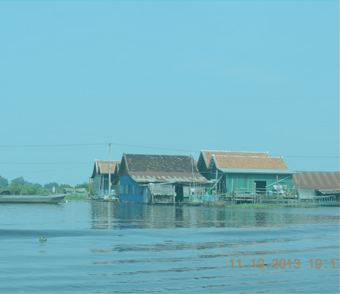The Natural Heritage Institute (NHI) recently delivered to the Royal Government of Cambodia (RGC) and the Government of Lao PDR (GOL) sustainable hydropower development plans that include a solar/hydro alternative that would supplant the need for new dams, thereby protecting the highly productive Mekong fishery and keeping sediment and nutrients flowing to the delta, which are necessary to prevent the delta from disappearing completely due to climate change. The alternative plans that NHI delivered to the RGC and GOL are technically rigorous products of a team of world-class interdisciplinary experts.
NHI is generating credible information for key decision-makers on technically sound and economically feasible alternatives, and building technical capacity so that governments can take a proactive role in deciding in advance the locations, designs and operations of projects for which they will accept competitive applications from developers. NHI is shifting the way governments think about their options to meet their countries’ energy needs while taking climate-smart action that protects environmental resources and human livelihoods.
Cambodia:
- For the RCG, the assessment was conducted under a formal agreement (Memorandum of Understanding) with the Ministry of Mines and Energy, executed on October 20, 2014. The MoU charged the NHI Technical Team to assess siting, design and operational alternatives to the originally proposed Sambor Hydropower Dam on the mainstream of the Mekong River and also assessment of a no-dam alternative for power generation. The Sambor dam site is in the reach of the Mekong River that annually experiences the largest migration of fish in the world. A dam at this site could literally kill the river, unless sited, designed and operated sustainably.
- The final recommendation to the RGC in the November 2017 report, is that it should defer any commitment to a Sambor Dam while it pursues better alternatives, starting with the solar augmentation of existing reservoirs. Even the most fully mitigated alternative poses high risks. The solar alternative allows the RGC to defer making any commitment to a Sambor dam at this time.
Lao PDR:
- At the end of January 2018, NHI submitted the Sustainable Hydropower Master Plan for the Xe Kong Basin, the purpose of which is to assist the GoL in implementing its Policy on Sustainable Hydropower Development that was decreed by the Prime Minister on January 12, 2015. NHI focuses on the Xe Kong because of its extraordinary fishery values and the intense level of threat to them posed by imminent hydropower proposals. The Xe Kong is the last unobstructed major tributary of the Lower Mekong Basin and is therefore irreplaceable for spawning of migratory fish. In addition, it contributes more sediment to the Mekong Delta than any other.
- Conducted in full cooperation with the GoL, the Master Plan prepared by NHI presents an alternative development scenario that satisfies proposed sustainability criteria, and is based on sites that are not accessible to migratory fish because they are above existing barriers (already constructed dams in the Xe Kaman tributary) or so far up in the catchment that the fish visitations are relatively minor. These alternative projects would be designed and operated to allow flushing of sediments and to maintain a flow pattern conducive to the needs of the migratory fish. In the aggregate, these sustainable alternatives would provide enough power to replace the mainstreams dams.
- The major recommendation of the Master Plan is to defer any commitment to the mainstream dams and pursue instead the sustainable options in the rank order in which they are presented in the Master Plan, with the solar augmentation of existing reservoirs as the top priority. If there comes a time when additional power development from the Xe Kong basin is needed, the uppermost dams should be given a higher priority. The lowermost dams should not be developed under any circumstance because of their very large impacts.
Floating Solar PV Alternative:
- A common element in both of the sustainable hydropower development plans is a feasibility assessment of augmenting the power output from EXISTING hydropower reservoirs by integrating a floating solar photovoltaic component that would be operated in a hybrid mode. In the case of Cambodia, the proposed Sambor Dam would be replaced by deploying floating solar panels on the Lower Se San II reservoir, which is now built and has already exacted its environmental toll. In Lao PDR, the solution is to “hybridize” the Xe Kaman 1 reservoir, which would be the centerpiece of NHI’s strategy to replace all of the mainstream dams in the Xe Kong. In both cases, this approach would more than double the installed capacity of the hydropower facilities. The results show that this alternative would be comparable or superior to new hydro with respect to net economic benefits, reliability of power, timeline for deployment, and avoidance of financial risks. If these concepts are implemented by the power companies and national governments, these would constitute the two largest utility scale floating solar-hydro hybrid projects in the world, and could serve as a model for widespread adoption. With some 25,000 hydropower reservoirs now in existence, this could vastly advance renewable alternatives to carbon-based power generation.
NHI is now embarked on an implementation and dissemination phase to share the analytic methods and substantive results achieved in the Mekong context to propagate in other basins around the world that are facing similar threats.

